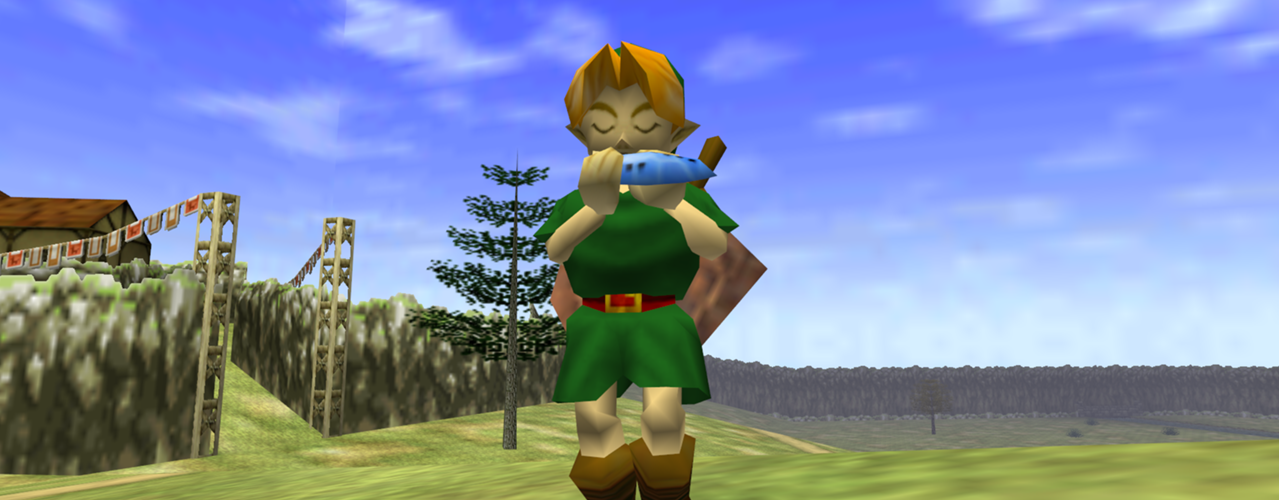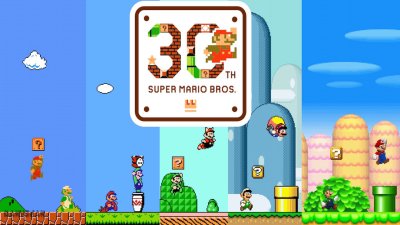“The rising sun will eventually set
A newborn’s life will fade.
From sun to moon, moon to sun…
Give peaceful rest to the living dead.“
This is the inscription on the Royal Family’s Tomb in The Legend of Zelda: The Ocarina of Time, initially released for the Nintendo 64 way back in 1998. While it certainty wasn’t the first major Legend of Zelda title, it was the first one in five years after 1993’s Link’s Awakening, and the first one to feature a wholly 3D environment.
Royalty has always been integral to Link’s experience; Link and Zelda have been intertwined for generations of princess-saving and sometimes role reversals, like Tetra in Wind Waker. But in Ocarina of Time, Link traverses the history of the royal family - or at least the dead remnants of them - in the Kakariko Graveyard, a monument to the dead on the outskirts of Kakariko Village.
Link, a child recently “liberated” from his false pretense as a child of the Kokiri Forest, has just begun his quest to become the iconic Hero of Time. He doesn’t know it yet, but he’s about to have his first brush with death, an experience that will scar both the cipher Link and the more human emotions behind the child in green.
At this point in his journey, Link has accomplished little, at least relative to the trials that he will face throughout the narrative. He has freed the Great Deku Tree of its prison of pain and suffering, but has robbed the Kokiri Forest of its wise and majestic seer, a seer who, despite his benevolence, has claimed to the Kokiri children that they will die outside the Kokiri Forest, a fate later learned to be false when some of the children leave on their own accord.
It was the right thing to do, the only thing to do, to end the Great Deku Tree’s corruption, but Link is thought of by his fellow Kokiri’s to be a murderer, a kinslayer, and a malcontent. Although not exiled, Link knows it is time for him to leave. He is not a true Kokiri, he soon learns, but a Hylain, and the Great Deku Tree has told him that his destiny is elsewhere, and that the Universe of Hyrule has a far greater destiny for a man like him.
As the Great Deku Tree explains to our young hero before his time of passing:
“For so long, the Kokiri Forest, the source of life, stood as a barrier, deterring outsiders and maintaining order of the world. But before this tremendous evil power, even my power is as nothing. It seems the time has come for the boy without a fairy to begin his journey. The youth whose destiny it is to lead Hyrule to the path of justice and truth.”
Only Saria, his one true friend among the Kokiri children, understands Link’s importance in the events to come, and urges him to make his own decisions and take up his destiny - however unclear at that present moment.
Before letting Link go, Saria offers him some parting words and gives him a Fairy Ocarina to remember her by, an instrument that will become far more important to Link’s well-being than Saria probably realizes.
“I always knew that one day, this day would come. I’ve always known we’re so different, and I’m not sad, because you have a lot ahead of you. I want you to take this. Don’t forget me.”
Link, the boy who will change the destiny of Hyrule, is now gone from the place of his childhood: alone in the world, unsure of his purpose beyond the parting prophetic words of the Great Deku Tree.
Traversing across Hyrule Field, Link’s most immediate, obvious destination would be the landscape-dominating Hyrule Castle, to figure out just how the heck he fits into this war against the mysterious Gerudo King of Thieves Ganondorf.
Ganondorf is a hard man, the first male to be born among the Gerudo desert tribe in over a hundred years, and is the leader of the tribe by birthright. He seeks to expand the influence of the Gerudo people, and alleviate their suffering out in the wasteland of Gerudo Valley, where the Gerudo have been exiled by the Hylains for untold generations.
Unaware of the politics of the age, Link just sees a cruel man with a cruel heart: corrupted by greed, power, and lust for conquest. While Link is ultimately proven right - after being tricked by the King of Thieves into doing his bidding and uniting the three Spiritual Stones - he has not yet encountered Ganondorf, and has only experienced his misdeeds secondhand.
Link’s possible first place of refuge after leaving his home is Kakario Village, a poor area residing well outside the influence and opulence of Hyrule Castle Town. Made up primarily of farmers, innkeepers and craftsman, Kakario Village is a rough-and-tumble destination, where only the most destitute of Hylains live. You won’t find any Happy Mask Salesman here, as that is a luxury that the people of Kakario Village just cannot afford.
It is questionable then, why the Royal Family Tomb can be found in the Kakario Graveyard. It may be because the Sheikah, Guardians of the Royal Family, originally took up residence in Kakario Village before opening it up to the more disenfranchised Hylains. It may be because this graveyard would be the last place that anyone would ever suspect, including Ganondorf.
But mostly, it seems, the reason for the placement of the Royal Family’s Tomb in this particularly destitute area is because of what lies beneath, if we recall the inscription on the tomb.
“The rising sun will eventually set
A newborn’s life will fade.
From sun to moon, moon to sun…
Give peaceful rest to the living dead.”
Quite literally, the living dead, the corpses of the royal family, are ReDeads, far before Ganondorf’s corruption makes these foul creatures manifest in the greater world of Hyrule. The living dead already exist in Hyrule, but they are confined to the Royal Family’s Tomb. And it’s up to Link, a mere child unaware of his destiny, to traverse the crypt and recover the lost Sun’s Song - a song eulogizing the deceased Royal Family of Hyrule, created by the Composer Brothers , Flat and Sharp, who gave their lives to protect the Sun’s Song secret.
After defeating them with his trusty Kokori Sword, Flat and Sharp reveal themselves properly to Link, explaining their connection to the Royal Family of Hyrule.
“Back then, people called us great composers because of the many musical masterpieces we wrote. But we brothers were not just composers. We had a mission to analyze the mysterious powers of Hyrule’s Royal Family. Our names would be a part of Hyrule’s history if we could complete our research!”
What just was this research exactly? And what are these mysterious powers that Flat and Sharp speak of? Whatever it was that they were working on, the Composer Brothers were lost in the annuls of Hyrule’s history, a mere footnote in the line of Hyrulian nobility. But maybe this is how it should have been, as their seemingly occult research damned the Hyrule Royal Family’s Tomb in ways that they did not expect.
No matter, it was time for Link to face his destiny, his first quest as the young aspiring Hero of Time. He would go down into the crypt, and he would retrieve the Sun’s Song.
Upon entering the tomb, Link’s fairy Navi examines the skeletal remains, shining her light on a nearby plaque.
“Those who break into the Royal Tomb will be obstructed by the lurkers in the dark…”
What does it matter? We’re already here. Let’s go.
It doesn’t look like Ganondorf did this. No, this is old, ancient occultism, from the time long before Zelda or Link. And now it’s Link’s destiny to confront it directly. Link descends deeper into the crypt, and is now in a room, the true bottom to the crypt.
ReDeads turn toward Link, remnants of the Royal Family of Hyrule, as though they had been awaiting him for some time.
Shackled by gravity and their own rotting flesh, they shuffle forwards menacingly. Link is terrified; any child of the late 80’s and early 90’s is terrified along with him. Player and character, closing their eyes from the shock and awe, run ruefully past the ReDeads.
They may bound you, they may gag you, they may put their crumpled flesh around yours, but you preserve - despite the scariness, despite the creepiness. You’re only a kid after all, and the most you’ve been exposed to so far are some odd-looking plants and a giant mutated spider. They are nothing in comparison to this real in-game horror show.
But you make it through, dodging the disgusting green ooze and the horrid ReDeads. On the other side of the bottom floor of the crypt is a plaque containing the notes of the Sun’s Song. You approach the plaque at top speed, stopping only to read the plaque, ominously recalling the fate of the living dead.
“The rising sun will eventually set
A newborn’s life will fade.
From sun to moon, moon to sun…
Give peaceful rest to the living dead.”
Etched into your memory, you grab your Fairy Ocarina and begin to play the notes, memorizing the song with the fury of survival. You’ve never been one for Ocarina playing, but after Zelda’s Lullaby and Saria’s Song, this is the most important song you know.
You play furiously, meticulously. A beam of light surrounds you, bringing down the sun, lifting the tomb from darkness. The ReDeads are stunned and Link, the hero - and you, the player - emerge from the traumatic experience you just had in the Royal Family’s Tomb with a renewed sense of purpose, reflecting for a moment on your first real brush with death. Link lives a sheltered existence no more, and neither do you.
Best to not tell Link then that getting the Sun’s Song was a completely optional experience in his quest to fulfill his destiny as the Hero of Time.
But it was a growing experience, for both player and character, and those are the experiences that matter most in games like The Legend of Zelda: The Ocarina of Time.

